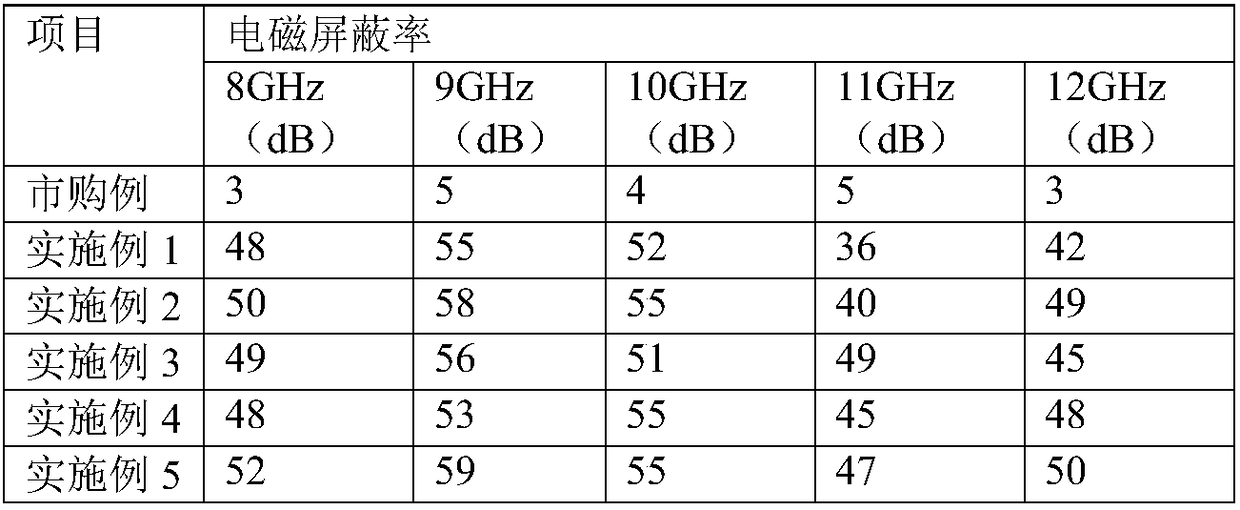Polyurethane foam for preventing electromagnetic radiation
A polyurethane foam, anti-electromagnetic radiation technology, applied in the field of special foam materials, can solve the problems of high cost, poor anti-electromagnetic radiation capability, low electromagnetic shielding efficiency, etc., and achieve the effects of low cost, reduced mixing performance and low price
- Summary
- Abstract
- Description
- Claims
- Application Information
AI Technical Summary
Problems solved by technology
Method used
Image
Examples
Embodiment 1
[0029] An anti-electromagnetic radiation polyurethane foam, said foam includes the following components in parts by weight: 100 parts of siloxane-modified phthalic anhydride polyester polyol, 80 parts of dimethylene benzene diisocyanate, nano-lead silicon tungstate 10 parts of gel, 25 parts of powdered graphene microflakes with a thickness of 40-80 nanometers and a width of 5-20 microns, 5 parts of carboxymethyl starch, 3 parts of melamine, 5 parts of ammonium polyphosphate, and 1 part of triethylenediamine , 0.5 parts of water, and 0.05 parts of dibutyltin dilaurate.
[0030] The preparation method of described siloxane modified phthalic anhydride polyester polyol is as follows:
[0031] (1) Preparation of silicone-modified polyol: take 100 parts of propylene glycol according to parts by weight, then add 5 parts of tetraethyl orthosilicate to it and stir evenly, then continue to add 0.5 part of glacial acetic acid and water 10 parts, and then stirred and reacted at 40°C for ...
Embodiment 2
[0036]An anti-electromagnetic radiation polyurethane foam, said foam comprises the following components in parts by weight: 100 parts of siloxane-modified phthalic anhydride polyester polyol, 100 parts of 1,4-cyclohexane diisocyanate, nano-tungstic acid 25 parts of lead-silica gel, 35 parts of powdered graphene microflakes with a thickness of 40-80 nanometers and a width of 5-20 microns, 15 parts of carboxymethyl starch, 8 parts of melamine, 10 parts of ammonium polyphosphate, triethylenediamine 3 parts, 3 parts of water, 0.25 parts of dibutyltin dilaurate.
[0037] The preparation method of described siloxane modified phthalic anhydride polyester polyol is as follows:
[0038] (1) Preparation of silicone-modified polyols: take 100 parts of propylene glycol in parts by weight, then add 10 parts of tetraethyl orthosilicate to it and stir evenly, then continue to add 2 parts of glacial acetic acid and water 15 parts, then stirred and reacted at 60°C for 5 hours, and evaporated ...
Embodiment 3
[0043] An anti-electromagnetic radiation polyurethane foam, said foam comprises the following components in parts by weight: 100 parts of siloxane-modified phthalic anhydride polyester polyol, 85 parts of isocyanate, 15 parts of nano-lead tungstate silica gel, thickness 25 parts of powdered graphene microflakes of 40 to 80 nanometers and a width of 5 to 20 microns, 10 parts of carboxymethyl starch, 5 parts of melamine, 8 parts of calcium polyphosphate, 1 part of triethylenediamine, 0.5 parts of water parts, 0.05 parts of dibutyltin dilaurate.
[0044] The preparation method of described siloxane modified phthalic anhydride polyester polyol is as follows:
[0045] (1) Preparation of silicone-modified polyols: take 100 parts of propylene glycol in parts by weight, then add 8 parts of tetraethyl orthosilicate to it and stir evenly, then continue to add 1 part of glacial acetic acid and water 12 parts, and then stirred and reacted at 50°C for 3 hours, and evaporated under reduced...
PUM
| Property | Measurement | Unit |
|---|---|---|
| thickness | aaaaa | aaaaa |
| width | aaaaa | aaaaa |
Abstract
Description
Claims
Application Information
 Login to View More
Login to View More - R&D
- Intellectual Property
- Life Sciences
- Materials
- Tech Scout
- Unparalleled Data Quality
- Higher Quality Content
- 60% Fewer Hallucinations
Browse by: Latest US Patents, China's latest patents, Technical Efficacy Thesaurus, Application Domain, Technology Topic, Popular Technical Reports.
© 2025 PatSnap. All rights reserved.Legal|Privacy policy|Modern Slavery Act Transparency Statement|Sitemap|About US| Contact US: help@patsnap.com

